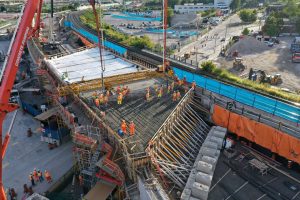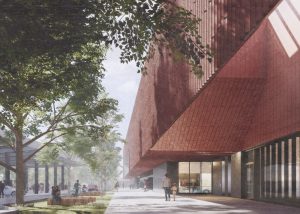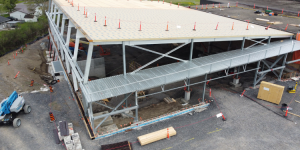News of a 40-storey wooden office tower planned for Sydney, Aus. is proof that mass timber construction (MTC) is gaining increased global acceptance as an alternative to traditional construction methods.
Tall buildings built largely from MTC demonstrate a trend towards structures now being dubbed “ply-scrapers.”
Promoters of MTC have long been enthusiastic about the reduced carbon footprint made possible by using engineered wood to replace steel and concrete. Not only does wood replace those carbon-heavy materials, the lighter overall weight of MTC structures usually means foundations require less concrete mass, further reducing embodied carbon inputs. Despite its cancellation, many have also praised wood’s esthetic appeal as revealed in the architectural renderings of Toronto’s Quayside project.
However, the 590-foot Australian project extends MTC well beyond the fairly common six storey height restriction. Such structures are made possible due to a hybrid combination of wood and steel. As reported in Popular Mechanics, the Australian design will use “a small amount of steel for core structural elements and then build out mass timber where possible, like the wooden dowels that help to hold up multi-tier cakes.”
“Wood/concrete composite systems have been around for a while and make sense,” Dominique Briand of Structure Fusion told the Daily Commercial News. “In certain heights where pure MTC is too light in terms of vibration and sound transmission, and weak in compression, concrete can be useful.”
Briand points to the proposed hybrid project in Toronto at 77 Wade Ave. as an example. Although more modest at eight storeys, the structure is large in overall area — approximately 150,000 square feet — and will be Toronto’s tallest MTC structure. Quebec-based Structure Fusion will supply what Jonathan King of BNKC Architecture and Urban Design describes as a “delta beam” that combines steel, concrete and engineered wood.
Further afield, Canadian real estate giant Brookfield Properties plans the construction of a six-storey, 310,000-square-foot office building in San Francisco as part of a $3.5 billion waterfront development. Because of the seismic sensitivity of the North American west coast, lateral steel seismic framing will be combined with cross laminated timber (CLT) flooring and metal cladding to deliver the required structural integrity. Brookfield has clearly expressed confidence in wood structures in seismic areas, while recognizing the lower foundation costs, offsite prefabrication potential and quick onsite assembly.
However, acceptance of MTC as a building material in large buildings, in either whole or in part, is not universal. Despite tests by safety authorities around the world, including Canada, concerns over fire resistance continue.
As reported in Alberta’s Lethbridge Herald, Brad Readman, president of the Alberta Fire Fighters Association (AFFA), said any positives related to wood construction for the forestry industry must be measured against concerns for the safety of first responders and occupants should fires break out in the taller MTC structures being proposed.
“Smaller communities around don’t necessarily have the capacity with an aerial apparatus high enough to fight those fires,” he said.
Those reservations are shared by Lethbridge Professional Firefighters’ I.A.F.F. Local 237 president Warren Nelson.
“We have concerns with these large buildings solely being made of wood, and the potential for rapid fire-spread throughout these buildings.”
The AFFA is asking provincial authorities to halt building code changes currently under consideration that would permit MTC structures as tall as 12 storeys until the federal building code is reviewed later in the year.
According to various Lethbridge officials, worries also centre around what they call “fuel load” during construction, coupled with the high winds typical in the Lethbridge area.
In the U.K., leading CLT manufacturers are investing half a million pounds in developing a new fire safety compliance framework for CLT to meet the amended building regulations in England, a country still haunted by the tragic Grenfell Tower fire, says the U.K .publication PBC Today.
“The project is a collaboration of the largest suppliers in Europe supported by leading fire and structural engineering experts.”
Nevertheless, alongside regulatory efforts to understand and mitigate the fire risks, global momentum appears to favour MTC.
John Bleasby is a Coldwater, Ont. based freelance writer. Send comments and Inside Innovation column ideas to editor@dailycommercialnews.com.











Recent Comments